#i feel like corvids are the most common - even jays and such
Explore tagged Tumblr posts
Text
the yi sangela post
I’m having autistic zoomies right now
I want to talk about Yi Sang and Angela because I like them both A Lot and I just think it’s fun to do comparisons. My partner made this lovely checklist with a few similarities I jotted down in a notesapp on my phone before I passed out and I will be cooking a meal thats geared solely to me but ur welcome to try and eat it if u want

Let’s get into it. There is no structure here but maybe we will find it as we go along!
I wanna start w a disclaimer that this is FOR FUN its not actually that serious and ALSO its obviously not a 1-to-1 comparison because these two are also so starkly different in not only their circumstances but also their overall personality when it comes to having deal with said Issues. I feel like tumblr users are more chill these days but after some shit ive seen on projmoon twitter I am covering my bases this is just a Post by a Stranger Online LOL
Let’s take a look at our first point on this silly little chart. That point is:
Bird
Angela’s black dress heavily resembles the feathers of a bird; specifically that of a corvid like a raven or even crow.



Even her head librarian outfit has some bird motifs to it. I’m going to get into corvid symbolism in a second but first
Yi Sang also leans heavily into the bird motifs. His base EGO is named Crow’s Eye View after a poem by the RL Yi Sang, and the narrative draws some inspo from the short story The Wings by the same author.
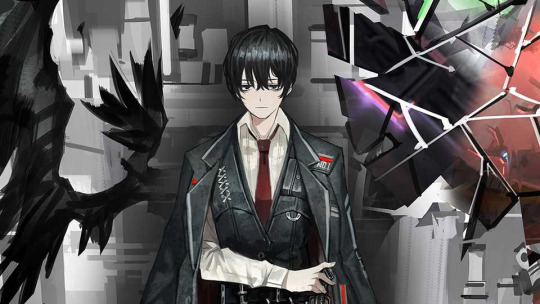
Wings show up often in some of his EGOS and CGs
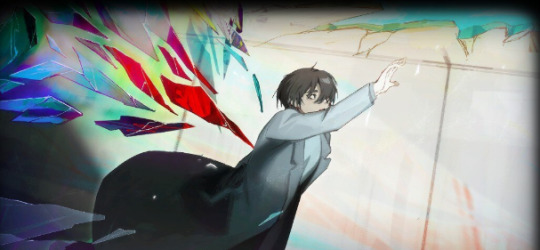
Now, it’s not simply generic birds either of them are inspired by; Angela’s black feathers, Yi Sang’s EGO title, they are specifically invoking corvids. Corvidae include many different species of birds, such as magpies and jays, but the most commonly thought of corvids would be the ones with black feathers; ravens and crows. Corvids are incredibly intelligent birds, and they are rich in symbolism and meaning.
Specifically, crows have a heavy association with death and the afterlife. Both Angela and Yi Sang are impacted by heavy losses; Angela is made from a woman who took her own life and is forced to oversee countless loops of people suffering and dying; Yi Sang witnessed his friends being driven apart in a violent manner. His two childhood friends die before him, he wishes he could kill himself and die, and is trapped in a purgatory state with his current coworkers where bloodshed is as common as breathing. Death has marked both of them.
But! That is not the only thing corvids symbolize! In more modern times the birds are said to also symbolize transformation. In a way, that ties into death, as what is death if not the final transformation in life? But neither of their final growths end in their deaths; rather, both learn to find a way to free themselves from the shackles of their past, and to push forward.

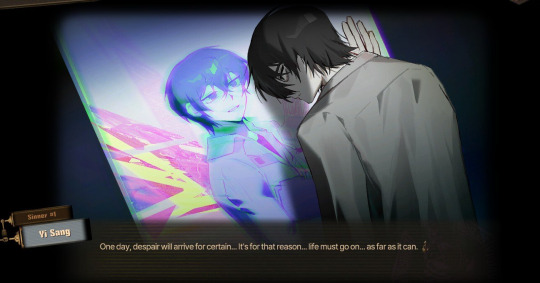
THEN WE HAVE
Book as weapon
This one is just silly.

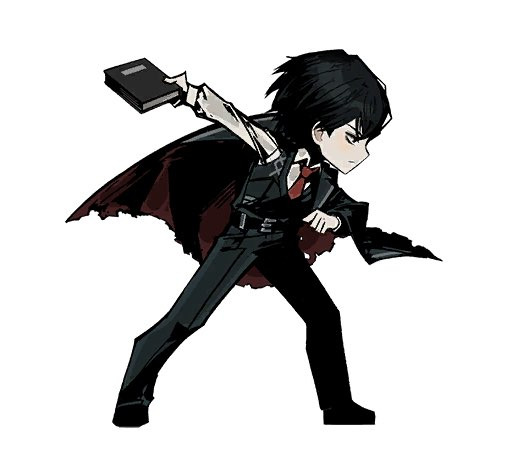
*beats you to death with a book beats you to death with a book beats you to death with a book*
Next point
Narrative haunted by a female figure
This one is in that “not a one-to-one comparison” territory, but it’s still just fun to poke at imo. In Angela’s case, she can never truly escape Carmen’s influence over her. For Yi Sang, Dongbaek is a ghost from his past. Both these women are integral to the overall narrative at hand.
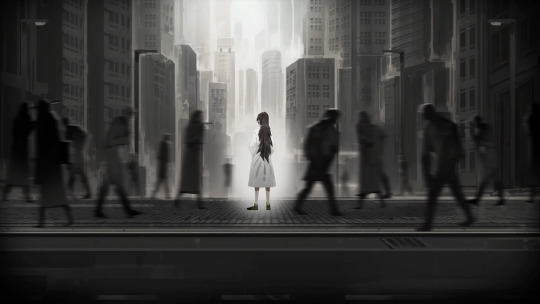

Not only do these women haunt the narrative, but they also mirror the person they haunt. Angela’s desire for life is so strong because, in the end, Carmen wished to live. Dongbaek admired Yi Sang and his dream of flying. She yearned to bloom in a way not dissimilar to a bird spreading it’s wings for the first time. Angela’s Lobcorp design invokes Carmen- her hair color is Carmen’s inverted. She wears the hair time Carmen wore. Dongbaek’s hair has become white from the trauma- the inverse of Yi Sang’s black hair. Yi Sang takes up a Dongbaek identity in a mirror world to further drive home the similarities. These women play a major role in the overall identity of these two characters.
And this is just my brain going “hehe neat” but Carmen’s whole like. Brain stem mimicking a tree and its roots. Dongbaek becoming flowers. Visually very similar vibes.
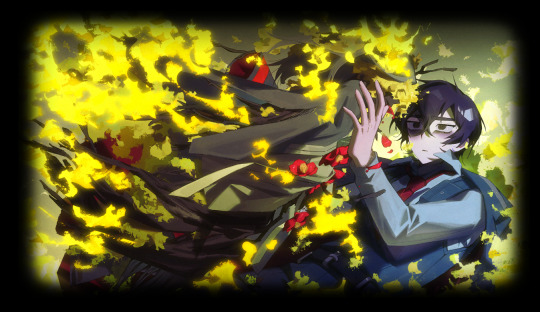
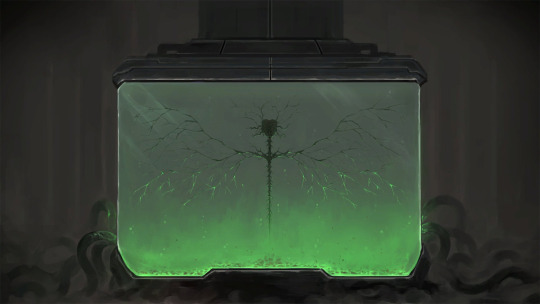
Onto the next point
Loomed over and controlled by a male figure
This one probably seems second most self explanatory. Ayin meet Gubo Gubo meet Ayin ect.


The deal is simple: you do what we want you to do, and we have employed dubious methods to ensure that you do what we want you to do! Both Ayin and Gubo are self serving when it comes to the end goals. The levels of agency at play here are different; Angela truly had no choice, but Yi Sang’s mental state is not Great and that is being capitalized on him to help perpetuate his isolation and dependency.


Another thing: Ayin and Gubo are just really fucking mean to Angela and Yi Sang. Ayin actively dehumanizes her and neglects her; Gubo verbally and mentally abuses Yi Sang. Fun stuff.
Now, the penultimate point:
Yearning for freedom
This naturally comes with the territory of being a bird. Angela longs to not be confined to a place (Lobcorp or the Library). She wants to experience the world and be free. Yi Sang is similar; that desire to spread his wings and fly. For both to accomplish this, they have a talk with the ‘self’. It’s only by confronting their pasts, and themselves, that they can finally get that push to live life on their own terms.


MY FINAL TALKING POINT
SEXY

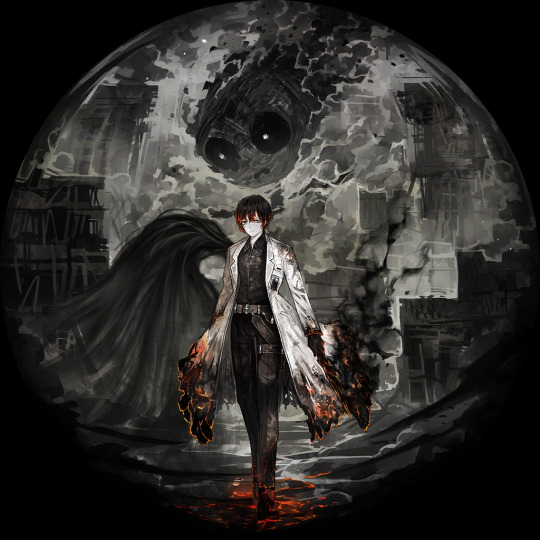
Like wow hot a what? And yes I chose fourth match flame because it ties into the whole post like they’re sharing an EGO that’s basically having your hopes burnt to a cinder and also an intense longing for a better life whoa thats crazy
Concluding thoughts
I just like them both a lot. My little caged birds getting out of the cage and mending their broken wings in order to take flight. Very kino. I love them.
If u actually read this thanks ur pog
#project moon#library of ruina#limbus company#not spoiler free#yi sang#angela#long post#perhaps they should... no i shant say it
155 notes
·
View notes
Note
Hey. Saw your "ask me abt corvids". Gimme a lecture on bluejays pls I love those funky lil asshats
My primary interest lies in crows, branching out heavily into magpies (they’d probably be my favourite corvid if any lived near me) and ravens, with bluejays as the irrepressibly stupid cousin-in-law that I, the Crow Witch, know only through those awkward family reunions where you chat about the weather and pretend not to know that Uncle Fred has a nasty habit of stealing ritual stones from cemeteries, yknow?
Having said that:
Blue jays are one of the most noisy and territorial breeds of corvid, more so than crows and even magpies. They will fight pretty much anything with a face, and the feeling is mutual--despite the fact that blue jays rarely eat any other birds, most species will respond with immediate aggression if a blue jay gets too close. Probably for good reason, as they’re notorious nest thieves (especially preferring to hijack robins’ nests if they can manage it). They’re known for being raucously loud and pushy, yes, but blue jays can also be downright sneaky when they want to. Stealth home invasions and subsequent habitation of other birds’ nests are a popular alternative among jays to doing the hard work of building their own place.
Jays are also alleged to appreciate shiny objects, snatching and carrying them off (though probably not hoarding or collecting them). However, it’s hard to find credible sources on this, and given that the widespread understanding of magpies as doing the same was recently demonstrated to be false, I would hesitate to put too much stock in the idea without further research. Then again: young corvids are the delinquent hoodlums of the bird world, everyone knows this, and it’s far from implausible that particularly daring young jays would take an interest in flashy things that catch their attention. Corvids are, after all, curious creatures.
What blue jays do, without question, actually hoard are nuts and seeds. They parallel squirrels for their tendency to hide their food away for later, and like squirrels, they often just straight-up don’t come back for it. This has led to initiatives like this Santa-Cruz research effort to use the local jays for reforesting purposes to combat fire scars. Jays are actually much more efficient reforesters than squirrels and other nut-hoarding mammals, since they tend to hide their foodstuffs in highly dispersed locations, whereas squirrels and chipmunks typically have only a few hoards located close to their home tree. Also, multiple studies have shown that jays will only select perfectly viable seeds to take to their cache--any acorns or seeds that have been tainted with rot or infestation are left lying on the forest floor. (tw for discussion of animal death in that particular link, though)
Also! Yes, jays are known for their raspy loud cry, but like other corvids, they have a vast repertoire of other sounds and a strong capacity for mimicry. They’re often known to imitate the sounds of their more common predators, making up for their slow flight patterns (which render them easy midair targets to hawks) by tricking local birds into thinking they’re dangerous!
anyway corvids are cool, blue jays are valid, and thank you so much for swinging by with this ask, friend
31 notes
·
View notes
Note
Happy STS! ❤️ I really love so much all the lore/worldbuilding things you post about your wips... Like Tybee's puzzles, and that story about the stars, and this other story about the goddesses too... Can I have anything more about it? Any kind of lore or worldbuilding facts? Thanks, I'll love it -chauceryfairytales
Here is an old file I found called “A bit about shapeshifters”. I hope this fits the bill @chauceryfairytales
A bit about shapeshifter races in Asylum
A preface: All modernday shapeshifters share a common origin, long lost to ancienthistory. The magic that forged them drew inspiration from thenaturalized world, from the fey creatures that arose from theElements. While modern peoples neither know nor care about theseorigins, it is worth keeping in mind that not every shapeshifter iswhat it seems, or thinks itself to be. Those with fey origins, nomatter how remote, are subject to different realities about magic.Those of the common shapeshifter ancestry have lost much of theirmagic over the generations, and now, most individuals are “normal”,outside of carrying a second animal soul.
Serpents: venomous(cobras, vipers) and non-venomous (pythons, and boas)
The venomous lines tendto have powerful magic, usually mirroring the color of their scales.Pythons and boas usually do not, though some interesting individualshave popped up here and there. In ancient times, cobra magic usuallydominated anyone of split parentage, and venomous tended to rule outover non. It is possible to be born split formed or blended form,displaying the talents and scales of both parents. Usually, suchpeople still only have a single serpent form, but there are rumoredto be some who call two entirely separate sets of scales.
For various reasons,serpents are often hit hardest during times of fear and war. Many ofthe lines known in ancient times are long lost, and with them, themagic they carried. Stories remain, but to most, they are just that:stories.
Avians: raptors (owls,hawks, eagles, and falcons) and passerines (basically any bird thatisn't a predator) *and corvids
Divided into twoclasses, the raptors and the passerines, based loosely on the birdtype they call. An ancient legend says that the first passerine wasborn when he lay down his magic willingly, to foster peace in awar-torn world. In our modern world, it is true that passerine typesalmost never have any magic, but even in the raptor types, magic isless and less common. Those raptors who do possess magic tend to bevery old, and very secretive. This may be due to the still lingeringdistrust of the griffics, a legendary nation of chimera: gryphons,hippogriffs, and wyverns. Even though nothing but rumors remain ofthe nation today, their reign was so absolute, fear of winged magicis hard to forget.
*Crows, ravens,magpies, and jays make up an outlier group known as crovids. Magiccan be found in their ranks, but not often. Some of these shiftersare of a similar background to the first passerines, while otherscome from more fey-like origins. The legends and superstitionssurrounding these groups are as varied as the cultures they findthemselves struggling to be a part of. In Riverside, most of thecorvids live uptown with the raptors, in a loose alliance with thewitch community. But it is equally common for corvids to integratewith passerine groups, or, in large enough numbers, to form their ownunits.
Felines: nations(tigers and lions), families (leopards and panthers), and solitaries(any) *and foxes
Like most of thepredator races, felines are better known for their martial prowessthan magical. Aside from the lions and tigers, felines tend to besolitary creatures, forming small familial bands, if anything. Eventhe great tiger nations are made up of smaller tribes, operating asindependent war-bands unless called together by their overlords. Somefeline forms also crop up in mixed species family groups, especiallyin remote and wild places like the North and the West, where magic ismore common, and unpredictable. Such peoples almost never ventureinto the more modernized lands, and so little is known about them.But, presumably, they feel the same nomadic urge common to otherfeline types. Like the cat types they call, feline magic tends to befickle, and it is not uncommon for a first shift to occur as late asearly adulthood, though it can occur much younger.
*While foxes are notclassically feline, behaviorally, they fall into this category. Likethe corvids, their ancestry may be common with other shifters types,while other lines descend from fey types. Fox magic, when it cropsup, leans towards illusions and dreams, Fire, or Earth.
Canids The Pack(wolves) and the solitaries (jackals and coyotes) *and The Den(hyenas)
Straight up,traditional Werewolves, without all the moon-gaga, silver-fearingbullshit. Wolves form rigid pack structures, with clear lines ofdominance leading to their absolute Alpha. Occasionally, Lone Wolvesare tolerated within a Pack's territory, either by being minor enoughto ignore, or by paying appropriate tribute. Lesser canids likejackals and coyotes are either ignored, or bullied. Might makes Rightin the canid world, and so the fierce dedication to structure is allthat keeps them from tearing themselves apart like animals. Fiercelyterritorial, the health of the local wolf pack either meansmeticulously guarded Order in their area, or barely contained gangviolence. Thankfully, canid races tend to be devoid of magic. It isalso not uncommon for their shapeshifting magic to be controlled,monitored, or even suppressed by their group's energy until puberty.
*Call a hyena a dog andthey will bite you. Despite, or maybe because of, their similardominance behaviors, hyenas and wolves war nearly every time theyclash. As a general rule, hyenas fight less for dominance, usuallyforming a clear line of command based on experience and age, ratherthan brute strength. In Riverside, the local Den are somewhatmilitant, divided into small bands of four or five that look an olderleader, with those units grouped together to make a squad, squadsinto sections, and so on. Currently, there are five “generals”who form a council under the highest leader, known simply as The Den.
Herd: Horses and Deer*and rabbits
Herd families are adying breed. With the growing sprawl of urbanization encroaching onthe wilderness, wide open spaces are harder and harder to come by.Intimately tied to the land's own magic, fecundity is becomingincreasingly reduced as space is becoming a premium. In today'smodern world, horse families are less and less nomadic, buying up anyland they can and forming homesteads. They live in the most perfectdisguises: as horse farmers and cattle ranchers. Few nomadic bandsremain, serving as caravan guards and escorts in those remote placeswhere civilization refuses to take. Deer families, if they stillexist, are never seen outside of their native forests.
*While not properlyherd, rabbits crop up in those same odd families in the North andWest.
Misc.
Shapeshifter magicreflects the land it comes from. While some elements of form areinheritable, local elements influence the form a child's magic willtake. Nica, for example, is hawk like her father, but being born onAmerican soil, her soul took the form of a Red-Shouldered Hawk whenit reached for a specific shape, while his was something reflectinghis native European land. So, depending on a myriad of conditions, intheory, ANY naturalized animal could potentially show up in ashapeshifter's soul, provided it resonated with the basic type (bird,serpent, feline, canid, herd). Add to it the mingling of fey-typelines into “pure” shifter lines, and the magic becomes even lesspredictable.
7 notes
·
View notes
Text
crows and ravens are VERY cool i know but i think if i ever wrote a book that just aggressively used a bird for pure aesthetic it would be a mourning dove or something. some kinda pigeon for sure
#i feel like corvids are the most common - even jays and such#then you see cute little songbirds on book covers nextmost often and they're nice but rarely in-text aesthetic#but like. those soft little pigeons that hang out under my window begging for food? prettiest birds around#maybe make a whole thing about the birds having been bred to be working animals who rely on their people#and then abandoned on a whim and reviled on the edges of society#theres PLENTY of cool symbolism with pigeons and doves who are also the same bird
4 notes
·
View notes
Photo










Field Notes: Oaks Bottom. July 21, 2017.
I've just dropped off my 12-year old at the last day of his last summer camp. I'm presently unemployed and slightly anxious about what the future holds, but ready to take advantage of the free time I have on my hands. A walkabout at Oaks Bottom seems in order. It's early still as I drop down into south meadow, on fire with morning magic. Chicory, sweet pea, and Queen Anne's lace fill the grassland, thistle and teasel, vibrant and rich, exploding up, taller than me.
Pollinators, bees of all shape and size, out in droves and spreading their goodwill. Dragonflies I don't recognize patrol the area, hunting in their sporadic style. Song sparrows, chickadees, bushtits, robins, wrens, and Swainson's thrush. Cedar waxwings, resplendent in their fancy headress, play in the brush. Corvids out too: scrub jays, Stellar's jay, crows of course, and even ravens. The more I learn about this family, the more fascinated I become. I wonder, how do the crows feel when ravens show up from deeper woods? Are they non-plussed by their larger cousins, or are they a threat not to be tolerated?
Across the pond from the Springwater bike path, the purple loosestrife looks to be coming in. The crazy weather these past couple years had seemed to have quelled its expanse, but this mild summer might give the invasive yet gorgeous wetland grass a new lease. Two wood pallets drift lazily on the still surface. On one, a cormorant stands motionless. Almost if, by his non-motion, he's somehow invisible. I see you, dude. On the other pallet--which looks a raft straight out of a Mark Twain novel--a great blue heron patiently grooms. And high in a towering cottonwood, just 30 meters hence, another great blue sits perched, looking quite sleepy. How the heck can they balance so easily, even in slumber?
A small gaggle of geese are seen through my field glasses, lounging in the distance. Seems a little late in the season. Maybe they're coming up north from way south? In fact, how far south is their range? Great drifts of fluff float in the air falling in slow-motion and pile up along paved paths and dirt trails, like low-laying clouds, or a dream, gifts from the regal cottonwoods.
Down along the bluff trail the spring runoff high-waters have receded, revealing the glade in its summer splendor for the first time in months. The brutal winter snowpocalypse took down dozens of trees; windfall--huge limbs and entire trees--is layered around the bottoms like an elephant graveyard. Revealed also: rusted out oil drums, chunks of concrete, and massive timber beams. Reminders that this spot was once an industrial waste dump. Imagine that... a one-time garbage dump, now widely acknowledged as a venerated natural area and part of the Pacific Flyway with countless bird species, right in the heart of Portland. Shows what humans are capable of when they get right with the world and put their mind to it.
I hear what sounds like an upset kingfisher, and the much quieter song of a barred owl. A smattering of mallards, greenwing teal, and a black duck with a white bib (domestic mallard?) gorge on a thick blanket of plankton in the shallows, loudly and audibly feasting. Chow time! Red-winged blackbirds jump around and say dee-doo, and dwee-dee doo, while a downy woodpecker male throws down infectious rhythms. Turn off your device and take out those earbuds, folks, there's music to be heard in these here woods if you but listen.
Western redcedar flush with ripe, green fans of cones. Fat buds hang heavy on Nutka rose. Big-leaf maples glowing, brighter than neon, telling me in no uncertain terms, Be here now. A gang of squirrels swing like gymnasts through the canopy of a hazelnut tree flush with fuzzy-jacketed shells, gleefully noshing the nut flesh then discarding the remains to the floor below.
Just twenty feet away, I stop and watch a blacktail doe, part of a larger group hidden behind a thicket of huckleberry and ocean spray. She's one of the most common large wild animals to share space with humans, and also one of the most beautiful creatures I've ever laid eyes on. I am humbled by her stature and her bearing.
I meander back to the car, filled with gratitude, present, and ready to take on what life throws my way.
0 notes
Text
HAS SUCCESS SPOILED THE CROW?
The Puzzling Case File on the World's Smartest Bird
Any person with no steady job and no children naturally finds time for a sizable amount of utterly idle speculation. For instance, me - I've developed a theory about crows. It goes like this:
Crows are bored. They suffer from being too intelligent for their station in life. Respectable evolutionary success is simply not, for these brainy and complex birds, enough. They are dissatisfied with the narrow goals and horizons of that tired old Darwinian struggle. On the lookout for a new challenge. See them there, lined up conspiratorially along a fence rail or a high wire, shoulder to shoulder, alert, self-contained, missing nothing. Feeling...discreetly thwarted. Waiting, like an ambitious understudy, for their break. Dolphins and whales and chimpanzees get all the fawning publicity, great fuss made over their near-human intelligence. But don't be fooled. Crows are not stupid. Far from it. They are merely underachievers. They are bored.
Most likely it runs in their genes, along with the black plumage and the talent for vocal mimicry. Crows belong to a remarkable family of birds known as the Corvidae, also including ravens, magpies, jackdaws, and jays, and the case file on this entire clan is so full of prodigious and quirky behavior that it cries out for interpretation not by an ornithologist but a psychiatrist. Or, failing that, some ignoramus with a supple theory. Computerized ecologists can give us those fancy equations depicting the whole course of a creature's life history in terms of energy allotment to every physical need, with variables for fertility and senility and hunger and motherly love; but they haven't yet programmed in a variable for boredom. No wonder the Corvidae dossier is still packed with unanswered questions.
At first glance, though, all is normal: Crows and their corvid relatives seem to lead an exemplary birdlike existence. The home life is stable and protective. Monogamy is the rule, and most mated pairs stay together until death. Courtship is elaborate, even rather tender, with the male doing a good bit of bowing and dancing and jiving, not to mention supplying his intended with food; eventually he offers the first scrap of nesting material as a sly hint that they get on with it. While she incubates a clutch of four to six eggs, he continues to furnish the groceries, and stands watch nearby at night. Then for a month after hatching, both parents dote on the young. Despite strenuous care, mortality among fledglings is routinely high, sometimes as high as 70 percent, but all this crib death is counterbalanced by the longevity of the adults. Twenty-year-old crows are not unusual, and one raven in captivity survived to age twenty-nine. Anyway, corvids show no inclination toward breeding themselves up to huge numbers, filling the countryside with their kind (like the late passenger pigeon, or an infesting variety of insect) until conditions shift for the worse, and a vast population collapses. Instead, crows and their relatives reproduce at roughly the same stringent rate through periods of bounty or austerity, maintaining levels of population that are modest but consistent, and which can be supported throughout any foreseeable hard times. In this sense they are astute pessimists. One consequence of such modesty of demographic ambition is to leave them with excess time, and energy, not desperately required for survival.
The other thing they possess in excess is brainpower. They have the largest cerebral hemispheres, relative to body size, of any avian family. On various intelligence tests - to measure learning facility, clock-reading skills, and the ability to count - they have made other birds look doltish. One British authority, Sylvia Bruce Wilmore, pronounces them "quicker on the uptake" than certain well-thought-of mammals like the cat and the monkey, and admits that her own tamed crow so effectively dominated the other animals in her household that this bird "would even pick up the spaniel's leash and lead him around the garden!" Wilmore also adds cryptically: "Scientists at the University of Mississippi have been successful in getting the cooperation of crows." But she fails to make clear whether that was as test subjects, or on a consultative basis.
From other crow experts come the same sort of anecdote. Crows hiding food in all manner of unlikely spots and relying on their uncanny memories, like adepts at the game of Concentration, to find the caches again later. Crows using twenty-three distinct forms of call to communicate various sorts of information to each other. Crows in flight dropping clams and walnuts on highway pavement, to break open the shells so the meats can be eaten. Then there's the one about the hooded crow, a species whose range includes Finland: "In this land Hoodies show great initiative during winter when men fish through holes in the ice. Fishermen leave baited lines in the water to catch fish and on their return they have found a Hoodie pulling in the line with its bill, and walking away from the hole, then putting down the line and walking back on it to stop it sliding, and pulling it again until [the crow] catches the fish on the end of the line." These birds are bright.
And probably - according to my theory - they are too bright for their own good. You know the pattern. Time on their hands. Under-employed and over-qualified. Large amounts of potential just lying fallow. Peck up a little corn, knock back a few grasshoppers, carry a beakful of dead rabbit home for the kids, then fly over to sit on a fence rail with eight or ten cronies and watch some poor farmer sweat like a sow at the wheel of his tractor. An easy enough life, but is this it? Is this all?
If you don't believe me just take my word for it: crows are bored.
And so there arise, as recorded in the case file, these certain...no, symptoms is too strong. Call them, rather, patterns of gratuitous behavior.
For example, they play a lot. Animal play is a reasonably common phenomenon, at least among certain mammals, especially in the young of those species. Play activities, by definition, are any that serve no immediate biological function, and which therefore do not directly improve the animal's prospects for survival and reproduction. The corvids, according to expert testimony, are irrepressibly playful. In fact, they show the most complex play known in birds. Ravens play toss with themselves in the air, dropping and catching again a small twig. They lie on their backs and juggle objects (in one recorded case, a rubber ball) between beak and feet. They jostle each other sociably in a version of "king of the mountain" with no real territorial stakes. Crows are equally frivolous. They play a brand of rugby, wherein one crow picks up a white pebble or a bit of shell and flies from tree to tree, taking a friendly bashing from its buddies until it drops the token. And they have a comedy/acrobatic routine: allowing themselves to tip backward dizzily from a wire perch, holding a loose grip so as to hang upside down, spreading out both wings, then daringly letting go with one foot; finally, switching feet to let go with the other. Such shameless hot-dogging is usually performed for a small audience of other crows.
There is also an element of the practical joker. Of the Indian house crow, Wilmore says: "...this crow has a sense of humor, and revels in the discomfort caused by its playful tweaking at the tails of other birds, and at the ears of sleeping cows and dogs; it also pecks the toes of flying foxes as they hang sleeping in their roosts." This crow is a laugh riot. Another of Wilmore's favorite species amuses itself, she says, by "dropping down on sleeping rabbits and rapping them over the skull or settling on drowsy cattle and startling them." What we have here is actually a distinct subcategory of playfulness known, where I come from at least, as "cruisin' for a bruisin'". It has been clinically linked to boredom.
Further evidence: crows are known to indulge in sunbathing. "When sunning at fairly high intensity," says another British corvidist, "the bird usually positions itself sideways on to the sun and erects its feathers, especially those on head, belly, flanks and rump." So the truth is out: Under those sleek ebony feathers, they are tan. And of course sunbathing (like ice-fishing, come to think of it) constitutes prima facie proof of a state of paralytic ennui.
But the final and most conclusive bit of data comes from a monograph by K. E. L. Simmons published in the Journal of Zoology, out of London. (Perhaps it's for deep reasons of national character that the British lead the world in the study of crows; in England, boredom has great cachet.) Simmons's paper is curiously entitled "Anting and the Problem of Self-Stimulation." Anting as used here is simply the verb (or to be more precise, participial) form of the insect. In ornithological parlance, it means that a bird - for reasons that remain mysterious - has taken to rubbing itself with mouthfuls of squashed ants. Simmons writes: "True anting consists of highly stereotyped movements whereby the birds apply ants to their feathers or expose their plumage to the ants." Besides direct application, done with the beak, there is also a variant called passive anting: The bird intentionally squats on a disturbed anthill, allowing (inviting) hundreds of ants to swarm over its body.
Altogether strange behavior, and especially notorious for it are the corvids. Crows avidly rub their bodies with squashed ants. They wallow amid busy ant colonies and let themselves become acrawl. They revel in formication.
Why? One theory is that the formic acid produced (as a defense chemical) by some ants is useful for conditioning feathers and ridding the birds of external parasites. But Simmons cites several other researchers who have independently reached a different conclusion. One of these scientists declared that the purpose of anting "is the stimulation and soothing of the body," and that the general effect "is similar to that gained by humanity from the use of external stimulants, soothing ointments, counter-irritants (including formic acid) and perhaps also smoking." Another compared anting to "the human habits of smoking and drug-taking" and maintained that "it has no biological purpose but is indulged in for its own sake, for the feeling of well-being and ecstasy it induces..."
You know the pattern. High intelligence, large promise. Early success without great effort. Then a certain loss of purposefulness. Manifestations of detachment and cruel humor. Boredom. Finally the dangerous spiral into drug abuse.
But maybe it's not too late for the corvids. Keep that in mind next time you run into a raven, or a magpie, or a crow. Look the bird in the eye. Consider its frustrations. Try to say something stimulating.
1 note
·
View note